
(Photos: J. Maus/BikePortland)
When the Portland Bureau of Transportation revealed their plans for SW Madison last week, there was at first rejoicing. Many of us are desperate for any change to our streets that makes bicycling and transit safer and more efficient. Dedicating a wide lane solely for transit and bike riders on a major downtown corridor is an exciting step in the right direction.
But almost as soon as we posted about the project, there were concerns about how this new lane would be shared by people operating such dramatically different vehicles.
PBOT crews implemented the $160,000 project over the weekend and Monday’s afternoon commute was its first real test. I rolled over to take a closer and ask staff from PBOT and TriMet a few questions.
The details
“It’s all about balancing the needs of everyone.”
— Hannah Schafer, PBOT
PBOT has restriped three blocks of SW Madison from 4th to 1st. On two of those blocks, 4th and 3rd, they’ve separated a bus/bike only lane from other lanes with plastic wands and curbs. The roadway is 36-feet wide from curb-to-curb. It used to have a standard, unprotected bike lane, two other vehicles lanes, and a lane used for on-street auto parking. Now there are two, 11-foot wide vehicle lanes, and one 15-foot wide bus/bike lane. The bus/bike lane is striped with what PBOT says is a “passing lane” for bicycle riders to the left of the curbside lane.
PBOT has also prohibited right turns for drivers at SW 3rd. This is the same corner where a truck operator’s right turn led to the death of bicycle rider Kathryn Rickson in 2012.
Driving space wasn’t reduced for this project. Buses will now get through faster with a carfree lane. Bicycle (and scooter) riders have a flexible space that is either five feet when passing a bus, or 15 feet if there’s no bus around.
Asked how they came up with this cross-section, PBOT spokesperson Hannah Schafer said, “It’s all about balancing the needs of everyone.”
The buses
Bus operators are generally more skilled and predictable than typical drivers. But the size of their vehicles makes them much more intimidating. The concerns about sharing this lane with buses is understandable. As you can see in the image above and video below, the space between the plastic wands/curbs and the bus is very tight and it feels stressful.
It’s worth pointing out however, that the condition shown in my video are not common. Usually the bicycle riders are either in front or behind the bus operator. TriMet Public Information Officer Tia York shared with me yesterday that 93 buses (from five different lines) use SW Madison between 1st and 4th avenues between 3:00 pm and 7:00 pm each weekday. I asked if they’d received any special training about using the new lane and she said no.
Advertisement
A few more things I noticed
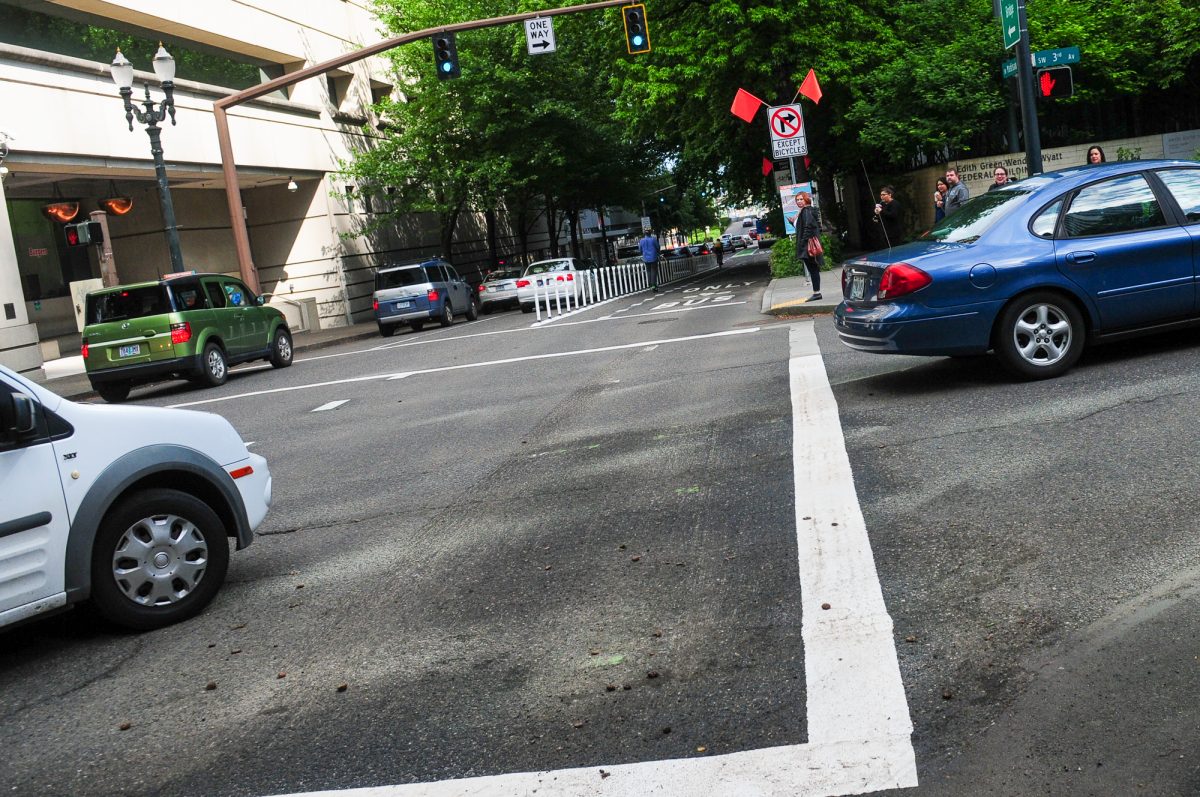
– Some drivers still turn right at 3rd. The only thing PBOT has done so far is posted a “No Right Turn Except Bicycles” sign up on the corner. PBOT Project Manager Gabe Graff said they’ll continue to monitor the behavior and make adjustments if necessary. One big step would be to color the entire bus lane red; but because red lanes aren’t officially sanctioned yet, PBOT would need to request permission from the Federal Highway Administration before doing so (something a few cities have already done). Red would become known as space only for buses, much like green has come to symbolize bicycle-only space.
– Despite technically having 15 feet to ride in, most bicycle riders filed all the way over the left whether or not a bus was present.
– PBOT plans to extend this treatment one block west to SW 5th once the construction zone adjacent to the Portland Building is gone.
– There’s no protection on the block between 2nd and 1st because PBOT said bus operators would have had a hard time maneuvering around them to continue onto the Hawthorne Bridge.
– The plastic wands and curbs have the added impact of slowing down the turns of drivers as they enter Madison from 4th and 3rd. This is a good thing. The street feels narrower with the plastic material in the middle of it, so people make sharper, more cautious turns while driving.
More photos

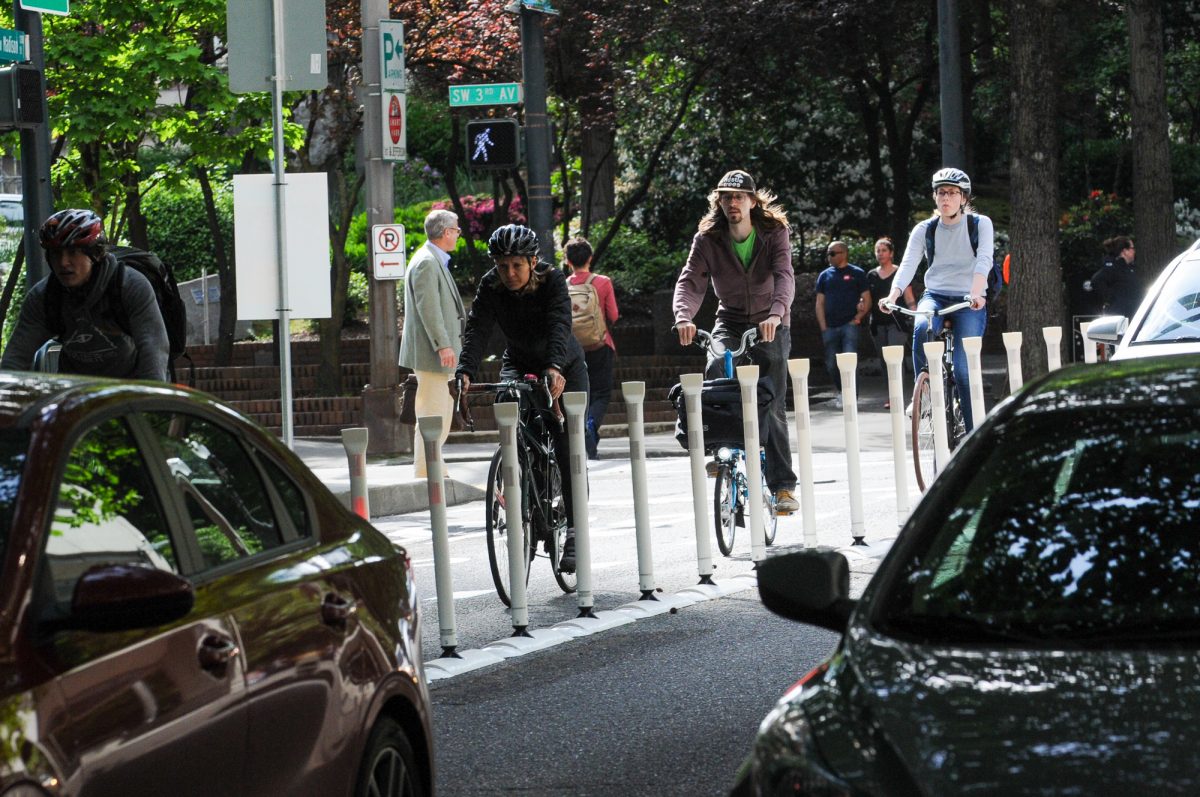

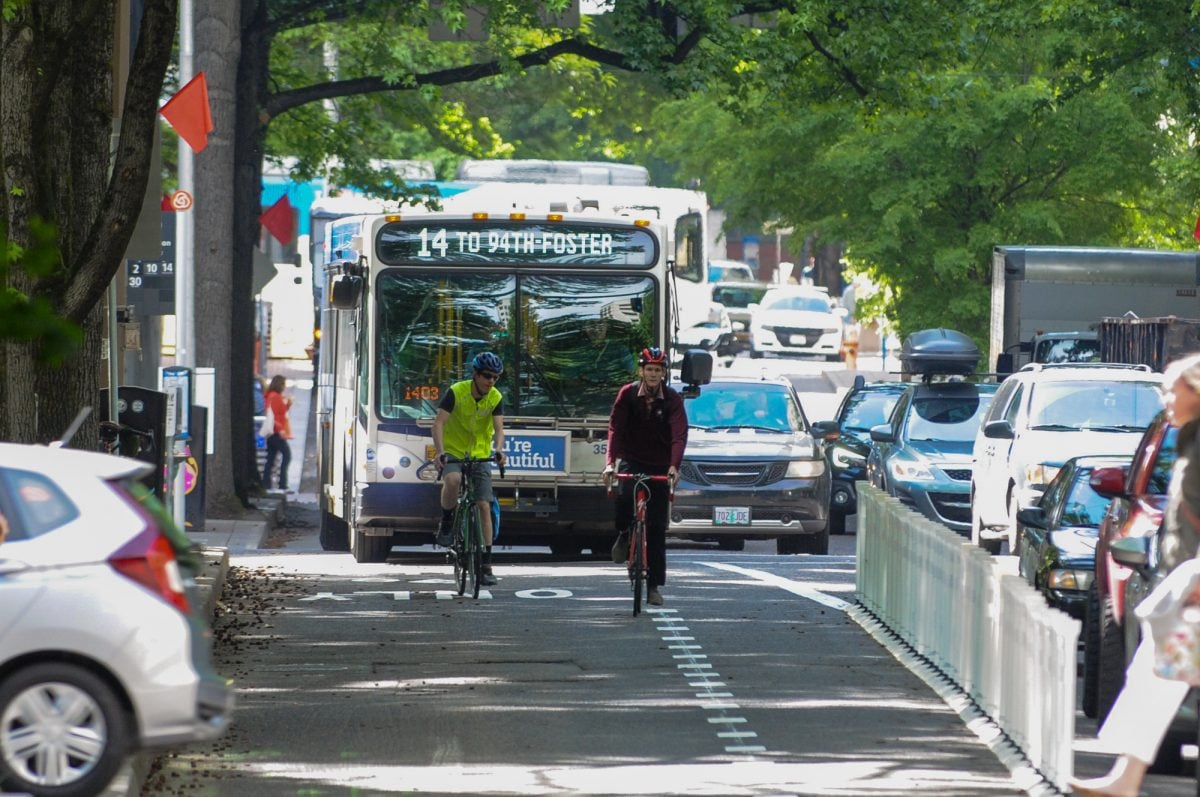

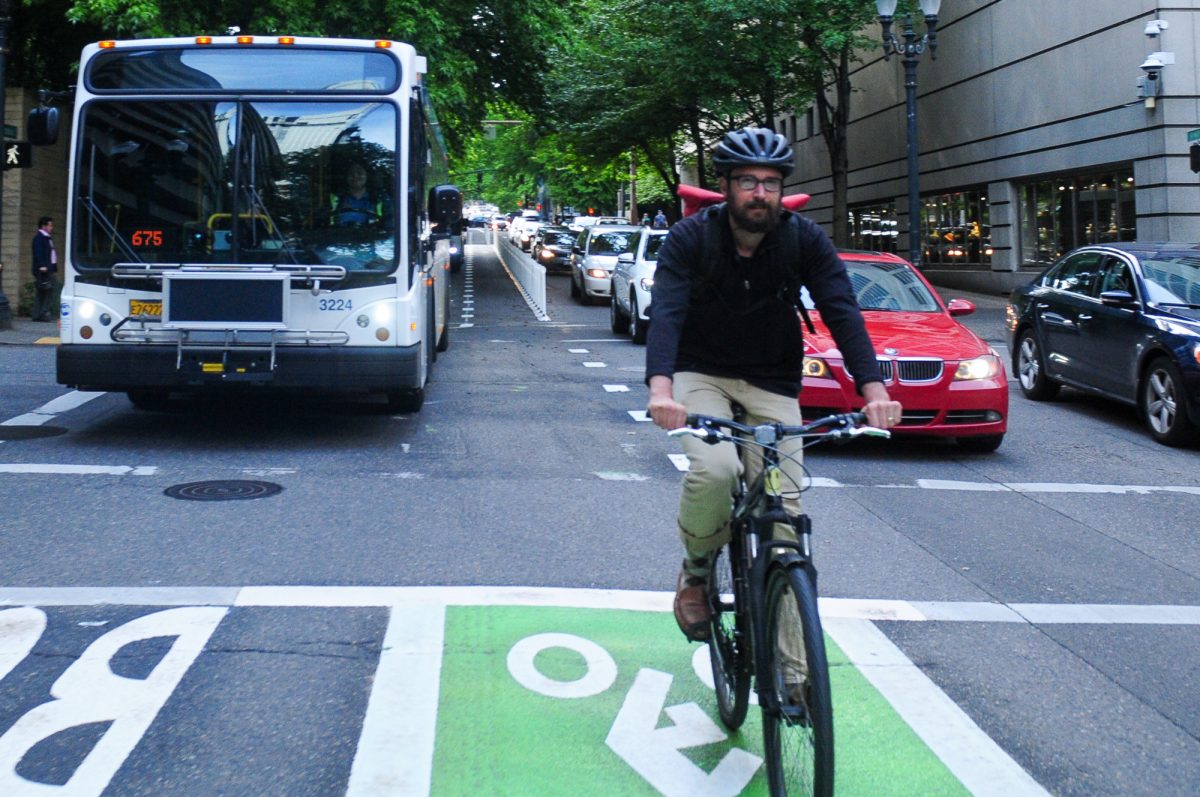
I didn’t talk to a lot of riders, but a few folks yelled out at me as they went by: “It’s wonderful,” said one. “Best thing ever!” said another. “So dumb!” said one guy, shaking his head.
Have you ridden it yet? If so, how did it go? What do you think?
— Jonathan Maus: (503) 706-8804, @jonathan_maus on Twitter and jonathan@bikeportland.org
Never miss a story. Sign-up for the daily BP Headlines email.
BikePortland needs your support.



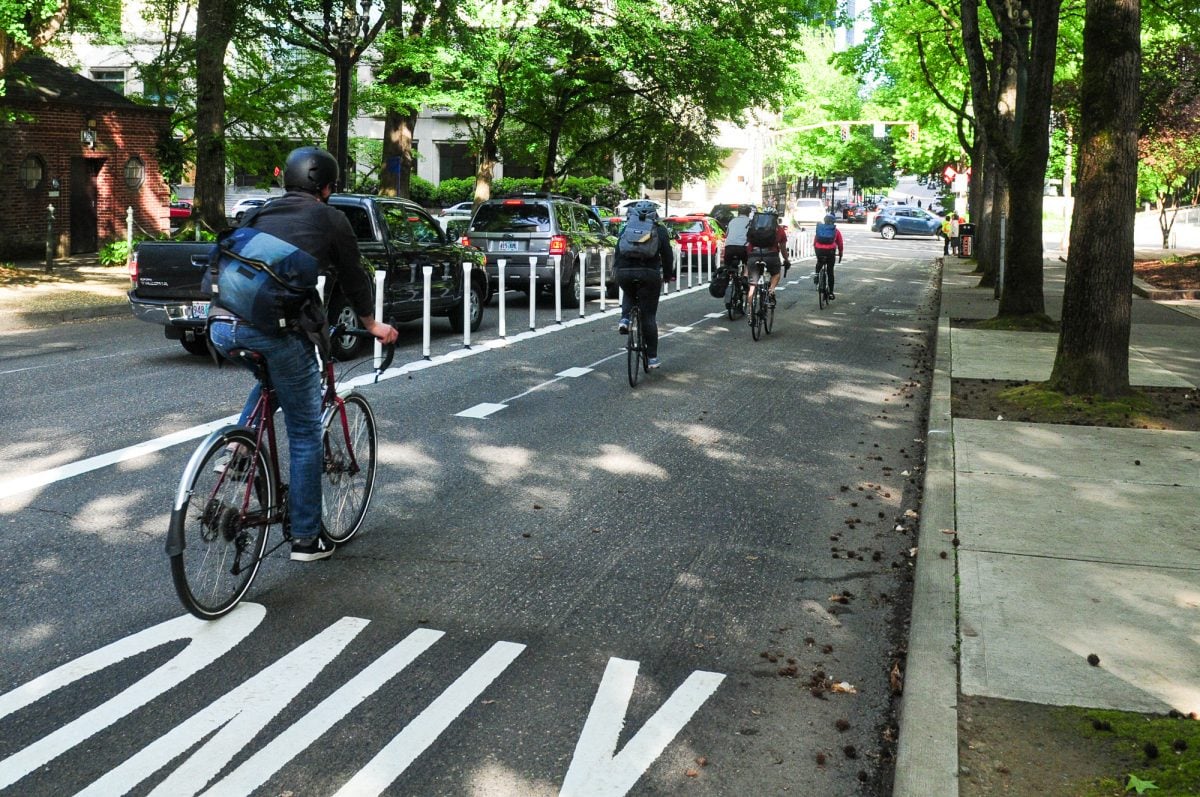
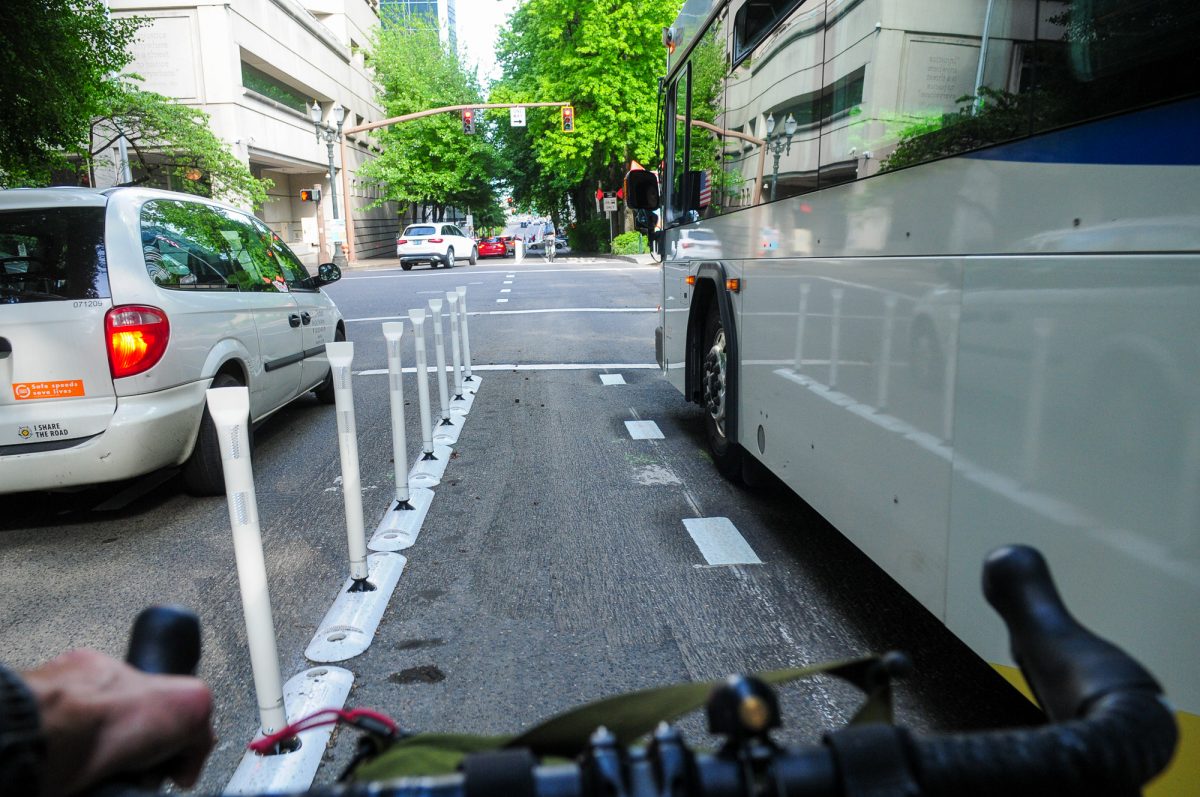

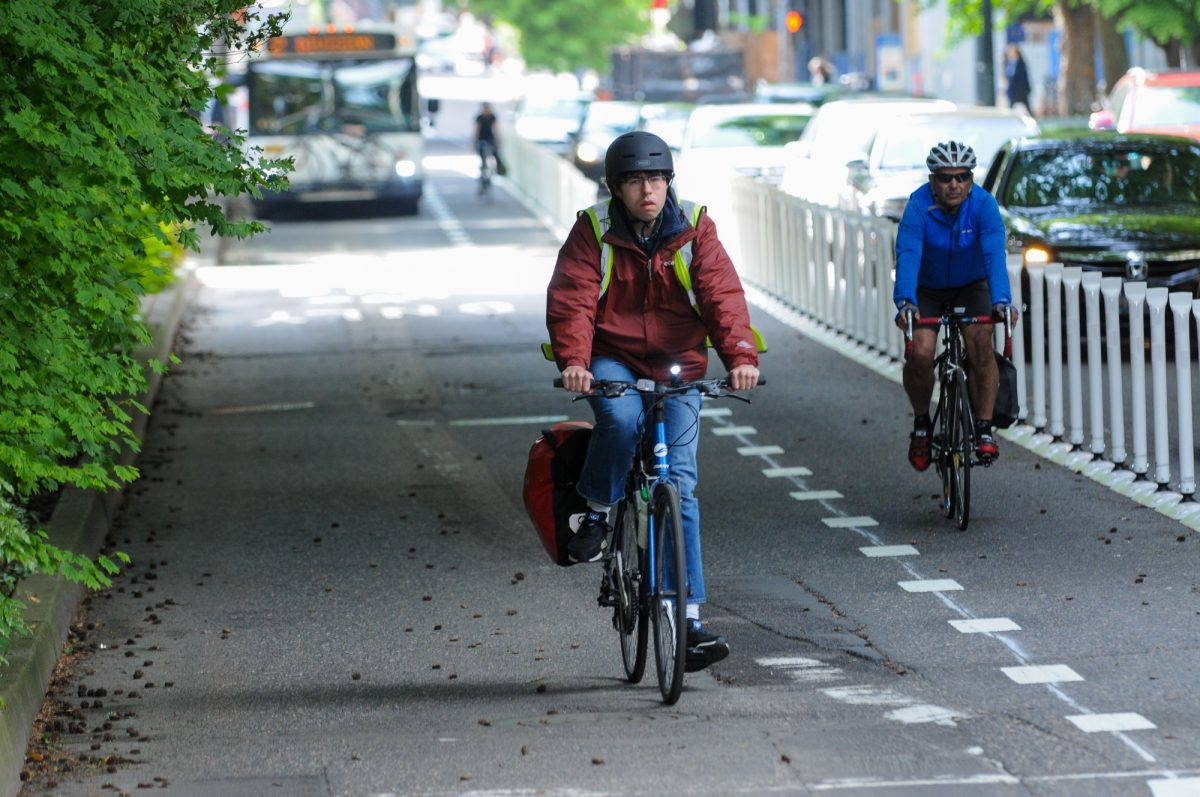
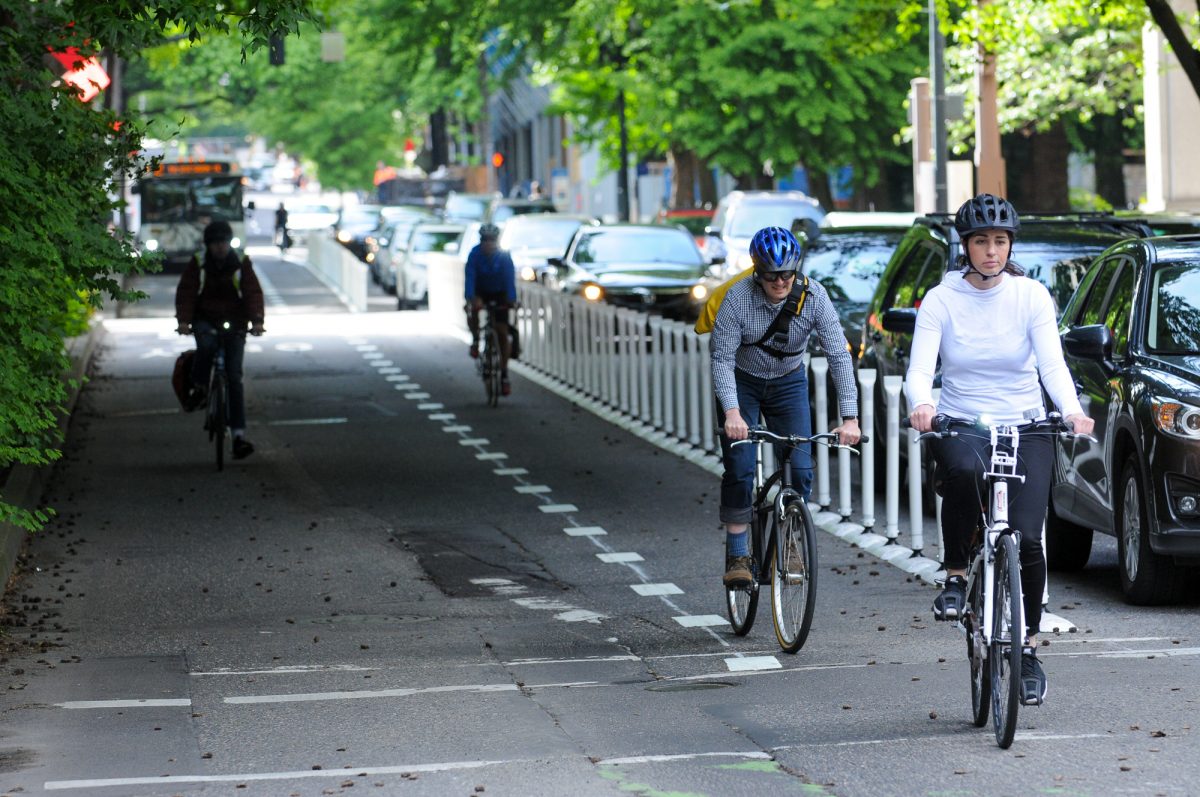
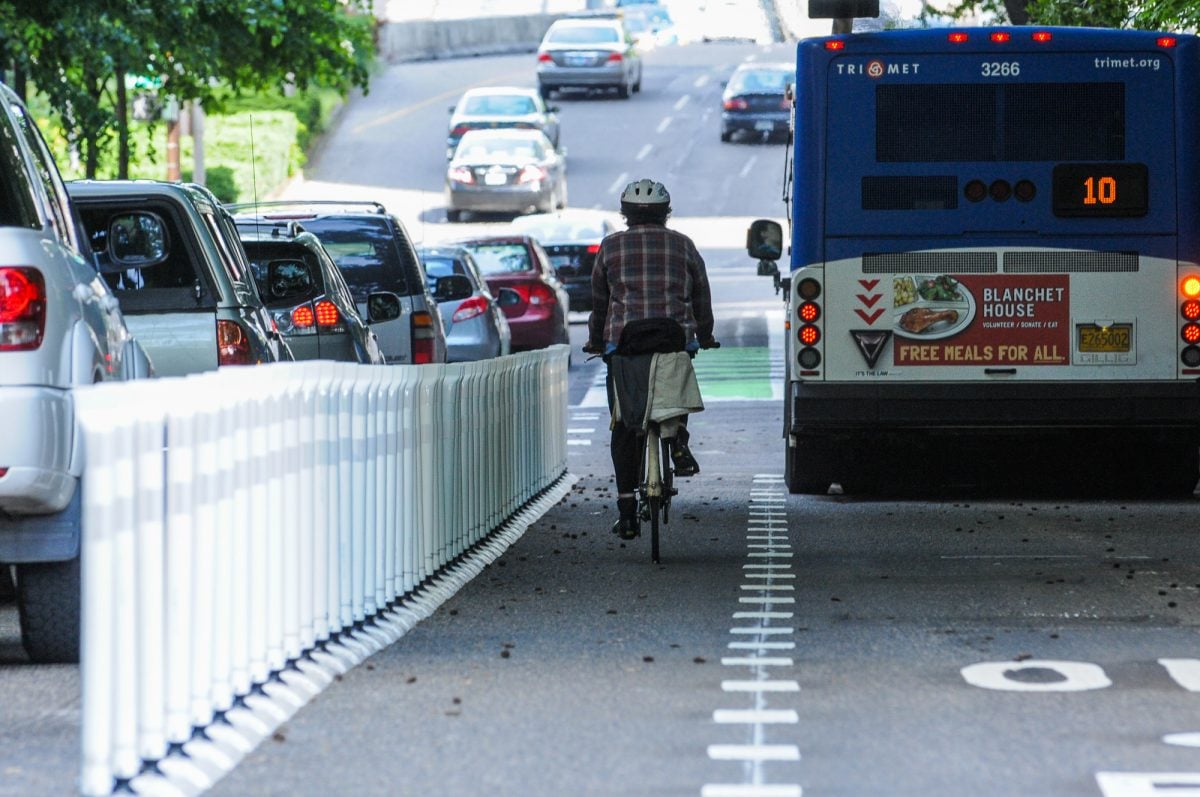
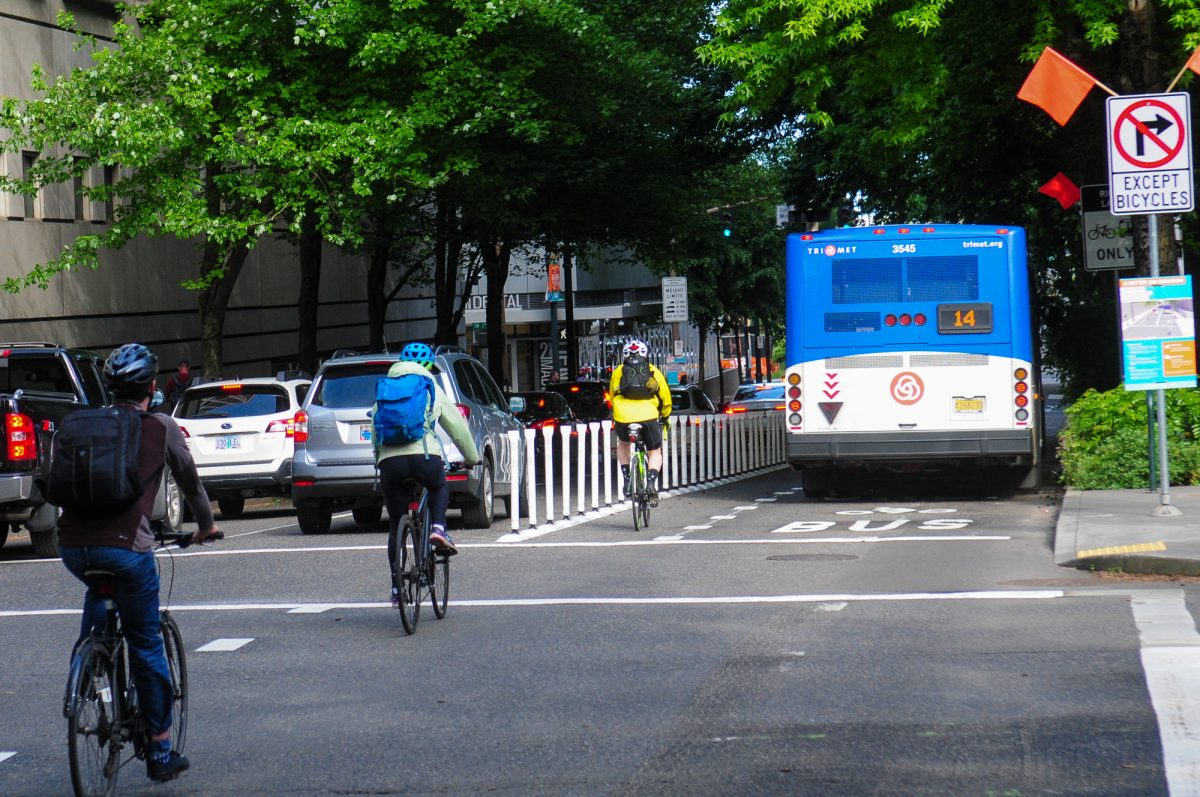

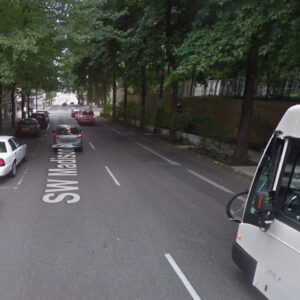
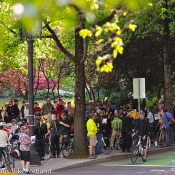
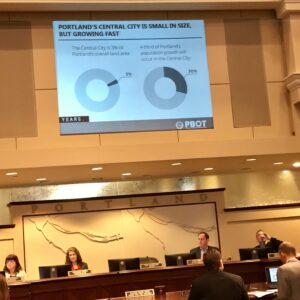
Thanks for reading.
BikePortland has served this community with independent community journalism since 2005. We rely on subscriptions from readers like you to survive. Your financial support is vital in keeping this valuable resource alive and well.
Please subscribe today to strengthen and expand our work.
interesting that the car has a California plate…..
California is a solid blue state in elections though!!!
Yeah, never seen one of those before. You think Californians are gonna start moving up here?
–” There’s no protection on the block between 2nd and 1st.”
This has always felt like the sketchy part to me. I don’t see why at least half of the block could not be protected.
The section between 2nd and 1st has indeed always felt sketchiest to me too, mostly because of the bus movements and stops there. But that’s exactly why it’s good not to have the bollards there – sometimes you need to be able to get over a bit to get around (or dodge) a bus.
Thanks, PBOT, for a quick, experimental road reconfiguration!
Better to do a basic design, install it quickly, and evaluate, than to spend years planning a full concrete upgrade that may need to be tweaked anyway.
Ted Buehler
Amen!
“on yer right”
No surprise bicyclists are staying far left in the shared lane, that’s where the best pavement is.
Looks like PBOT made liberal use of their pavement grinder while building this as well…
I think the right-turns will taper off with time as people learn the new rules. No right-turns on to a one-way street is an unusual configuration.
Right, just like how I never see anyone making right turns through a green bike box any more.
(I feel slightly bad for a sarcastic s**tpost, but then I remember HK does it all the time).
Looks dangerous to me but as you said this is not the only place with these sort of conditions.
Great reporting on the issue.
When I first saw you say you talked to Trimet I was hoping you’d ask about driver training. From your video it appears the far left bike passing lane is a good enough size for a bike to pass a bus stopped at a stop but is not appropriate for buses to be passing bikes.
I would like to see buses treat cyclists in this lane just like vehicles in an auto lane, when one is in front of them, stay behind them. Regardless of if the cyclist is over to the left and a bus could get by. This is just a legal nightmare if (and hopefully not when) a bus attempts to pass a cyclist as that same cyclist is moving to the right to use a different portion of their lane.
Either the rightmost lane needs to be bus only, or buses should absolutely not be passing cyclists. I would not move to the left so a bus could squeeze by, drivers need to be trained that this is a shared lane and bikes have no obligation to move over to let them by.
Full disclosure, I am a TriMet Operator.
I want to point out some nuances of this particular lane location as compared to another very similar one on the other side of the river heading west on Madison. The bus/ bike lane configuration on Madison Eastbound from 10th into Grand has the bus lane (with restricted auto parking times) and the bike lane side by side. The grade is slightly uphill. During the morning commute, there is a bus line 10 or line 14 every 6 to 10 minutes. During this same time, there are 100’s of bike commuters entering this stretch from 12th all the way into 7th.
Because of the uphill grade, the cyclists, for the most part, are moving slower than the buses. Therefore the buses are passing the cyclists. I have driven the 10 and 14 during the morning commute and can tell you it is not a problem. The road is straight, we don’t turn, there is good visibility ahead and behind and the cyclists are easy to spot. As a bike commuter myself, often riding next to buses, delivery trucks, semi trucks, etc., I can tell you your focus is intensified. You hold your line and focus while the bigger vehicles go past you. It’s just part of being on the road. The same is true when the cyclist does the passing as is the case on the newly stripped and bollarded section of Madison from 4th to 1st Eastbound. This stretch is downhill, so the cyclists are, for the most part passing the buses and many of the cars. Again, this is not a problem because the lanes are straight, the buses are not turning and visibility is good. With the old configuration, the bike lane and right side car/ bus lane crossed at the intersection of Madison and 2nd, with the buses forced to look right for bikes, left for cars, then cross over to the right into the service lane for the Madison and 1st bus stop while now looking left for bikes. I can tell you the sphincter pucker was strong every time through this zone. I have been through the new section on a bus, on a bike and on a scooter. It looks safer, feels safer and performs safer than it did before.
Thanks for the perspective. I agree it’s safer all around than previously and definitely support this (and definitely don’t doubt a bus operators ability to negotiate this). I just regret that our latest greatest bike facility is associated with phrases like “focus is intensified”. My main concern is making this a shared lane when maybe the volumes of cyclists and buses would benefit from making it a clearly separate bike and bus lane (like Madison). It’s just inviting subjective right of way interpretation (a la “bike-walk” crossings).
https://usa.streetsblog.org/2014/09/10/build-it-for-isabella-putting-a-face-on-why-people-hesitate-to-bike/
and remember, isabella, you just need to harden the **** up, intensify your focus, and hold your line.
Huh? What’s Isabella doing out in the street without a parent? Her parent(s) need to take some responsibility and stuff her into their SUV if she needs to go anywhere. Somebody call CPS.
My experience was that during rush hour this is the kind of facility that only a “strong and fearless” cyclist would fine remotely comfortable.
That being said, I *strongly* support this facility because I believe the needs of transit riders outweigh those of people cycling. IMO PBOT should emphasize alternative routes for people cycling and make this a bus only facility.
This project improves things for all modes — transit, bikes, and autos.
SW Salmon and SW Columbia are more comfortable and, arguably, safer routes to the bridge. Both of those could be improved for people cycling without creating additional conflict with the only mass transit route to the Hawthorne bridge. In my opinion, the decision to continue allowing people cycling to use a badly needed bus lane makes absolutely no sense.
Why not? There’s room for both. For now, it looks like an improvement for everyone. Let’s see how the facility operates in practice, and collect some data, before we draw conclusions.
I get this isn’t perfect, but if this is infrastructure for the “strong and fearless” I am terrified of what bike infrastructure for the “weak and fearful” will look like and more importantly, cost. Further, this route is the best of all worlds for cyclists, even those with less experience and bike handling skills. It is downhill and the lights are timed for 15mph. You can almost coast between the lights and make the greens, and now when there aren’t buses, there is room for cyclists to arrange themselves based on speed prior to the bridge.
Sure, but everyone’s got to get to the Hawthorne bridge eventually, unless you route some of the traffic over another bridge. Anyway, it’s only an issue during so-called ‘peak hours’.
People cycling don’t need to use this route at all. There is a protected ramp to the bridge deck that is easily accessible via SW Salmon or SW Columbia. Some dude on bike should not be able to cycle at 5 mph and hold up the dozes on people on a crowded rush hour bus — just because.
The experienced year-round bike bro entitlement on this thread is unbelievable.
Do you think this is likely to be an actual problem?
How would you propose to reroute bike traffic onto Portland’s busiest bike bridge? Most cyclists are of course not primarily coming from further west on Madison, but from somewhere to the north or south.
Maybe for cyclists coming from the north, a protected lane on SW Salmon, and then another one on first? And for people coming from the north, a protected lane on Columbia directing them to the (improved) Naito-adjacent path? It just might work.
Long-term solution:
San Francisco finished ripping out its shared bus-bike facilities on Market a few years ago. In contrast to the claims of 100% unbiased trimet bus operators above, buses do pose risk to vulnerable traffic. In fact, the SF shared bike/bus lane was notorious for the deaths and serious injuries that occurred on this facility. I really hope that these kinds of tragedies are not repeated in Portland but would not be surprised if they did. My preference by an enormous margin would have been for the city to stripe a protected bus lane and a protected bike lane on Madison. If there is not sufficient political will for both, I favor the bus lane alone. IMO, designating the current facility as a “bike” facility is a mistake and one that may very well negatively impact Portland’s already falling bike mode share.
Short-term solution:
The SW Salmon center Bike Lane is accessible from both the South and the North and is, IMO, a far more comfortable route than Madison at rush hour. It could easily be expanded to 4th.
A similar center bike lane could be added on SW Columbia. Both of these facilities could be protected when more funds area available.
As a 100% biased bicycle commuter, I am acutely aware of the dangers ALL vehicles (including other bikes) pose to me as I ride my bike to work, dinner, errands, etc. every day of the year. Buses are a very intimidating size and shape when you are on your bike and get passed by one, or pass one yourself. But I stand by my belief that the men and women behind the wheel of the TriMet fleet are much more focused on the road and ALL the chaos going on around them than are 1000’s of drivers of passenger vehicles we as cyclists encounter every day. A look at the bike vs auto accident stats compared to bike vs bus accident stats would prove this point.
I think the debate here, concerning this new Madison configuration, is interesting considering that when I drive the 44 down Willamette, Williams and Vancouver, I have dozens of interactions with cyclists each trip. The bus is extremely close to the cyclists all the way down these routes and we are required to weave in and out amongst the cyclists at virtually every stop. We have to time and gauge our pull-ins and pull-outs in a virtual dance with the bike commuters, cars and delivery trucks. Not to mention the construction which ultimately pinches the cyclists into the motor lane in several areas. There are ample opportunities for things to go wrong here. In my experience though, the bike/ bus relationship is so much better than the bus/ car relationship. The autos will do anything to get by the buses, and that includes endangering the cyclists. I have seen untold numbers of close calls due to auto drivers passing us in intersections, passing us in the bike lane on Williams when there are bikes in that lane, and ripping past us at crosswalks with people in them attempting to cross. And as a cyclist, this stuff gets me hot! That and the 80% of drivers I see from my seat, on their phones endangering everyone in their path.
Yes, I’m a 100% biased TriMet driver and a 100% biased cyclist. The Madison changes are good for bikes, good for cars, and good for buses.
I notice an awful lot of I statements. Perhaps instead of thinking about this infrastructure through the lens of your own experience. Through the lens of someone who is admittedly comfortable riding very close to move motorvehicles, buses, trucks, and semis:
…you might consider how this new facility might feel to someone new to cycling, to someone who is trying this route for the first time, to a younger person, to a person with less ability to thread the needle of traffic, to a person with less ability to balance, to people with wider bikes or trikes etc.
If we are going to assess a shared bus-bike lane then the appropriate comparison would be with other similar bus-bike lanes. The safety record for these kinds of shared facilities has been poor as this protest highlights:
https://www.thebaycitybeacon.com/politics/protestors-block-cars-from-market-street-call-for-safer-and/article_953dfacc-7069-11e9-a3c3-a344a51a3f7a.html
The existence of crappy bike lane infrastructure elsewhere does not address the specific risk of funneling bike traffic into an entirely new type of facility: a shared bus and bike lane.
Will Trimet do some coaching of drivers as to sharing space with cyclists–and is it possible that not having to share the lane with private car drivers will improve the mood of bus drivers? I’m probably not in the “strong and fearless ” (what a stupid phrase!!!) class but I would not be uneasy riding in that lane.
The first photo makes it clear that Trimet should use European style side mirrors on their buses, which do not whack bicyclists on the head.
Curious as to how many cyclists have been “whacked” by these mirrors.
Is the mandatory sidepath law (ORS 814.420) going to apply to this facility?
I want to say no, because it’s not a bike lane, it’s a multi-use lane. However, the definition of a bike lane (ORS 801.155) doesn’t state that the lane has to be exclusively for bikes.
So I think that any lane on the roadway marked for bicycle use is mandatory.
Could someone please explain the sidepath law? Does it mean that a cyclist *must* use a path if one is provided, such as the Tryon Creek path instead of Terwilliger? Thanks.
Fred,
The law (ORS 814.420) says, “a person commits the offense of failure to use a bicycle lane or path if the person operates a bicycle on any portion of a roadway that is not a bicycle lane or bicycle path when a bicycle lane or bicycle path is adjacent to or near the roadway.”
So yes, technically you have to use the path or bike lane if it’s there. However, like many laws, it’s squishy. Would Tryon Creek path qualify as “adjacent” to the roadway? Also, there are exceptions to the law. For instance, if you need to pass someone, turn left, or need to avoid debris or hazards. And of course this is one of those laws that is in the books but is almost never ever ever enforced. It is likely to be an issue, however, if you end up in court for some reason.
Yes, that is exactly what the side path law states. Repealing it has been a priority for many people.
Now I’m going to have to look even more carefully next time I ride through here. From the pics above, I don’t see a bike lane until 2nd, starting with the green paint. Even that could fail the definition of “Bicycle Lane” because it is not “adjacent” to the roadway—it is in the middle of the roadway.
Unless there are “Official Signs or Markings” designating “part of the highway, adjacent to the roadway, … for use by persons riding bicycles”, it is not a bike lane. I mean, if bike lanes used to disappear in intersections because the language was “unclear”, then it seems they still disappear and are not “mandatory” any time they are between two other moving traffic lanes—assuming that parking spaces are not part of “The Roadway”.
They are going to need much better signage (on the signals) and some enforcement to eliminate the right turn issue.
Right in front of the police station!
best place in town to break the law! I can’t remember when the last time I saw anyone from the traffic division ‘enforcing the law’ downtown unless there was some kind of protest.
I agree, better signage is in order. The sign really should be right next to the traffic signal. Drivers usually at least glance up there to see what color the light is, so that should be the most effective location for a sign prohibiting turns.
I find this misplaced signage fail all over town, and it makes it less surprising (but still rude and dangerous) when a driver turns anyway. The most often disregarded right turn prohibition on my commute is on NE Couch and NE Grand, as I head west to approach the Burnside Bridge. The sign is about 20 meters before the intersection, on the curb to the right of the roadway. Motorists approaching the intersection are looking either up at the signal, or left at the cross traffic, and never see the sign.
Is there a reason the sign is not at the signal, where the eyes are?
It should be a permanently illuminated no right turn light, immediately next to the signal.
Trimet should not need to perform special training for its drivers because of a four-block restriping project. That notion is silly. Trimet operators are trained to be alert and aware of bicyclists in all kinds of road design environments across the region. In my experience riding bikes in Portland for nine years, Trimet operators are alert, aware, and patient with bicyclists.
How much of your riding in the last 9 years have been in this kind of lane configuration? How many hours do Trimet drivers have operating in these kinds of lane configurations. Maybe not a drawn out / structured training, but I sure hope they are providing a statement to all drivers regarding the lane and that regular drivers for this route will be met with.
“Training”, in this case, I think would be an email to the drivers saying something like, “Don’t move the bus into the bike lane. Bikes can be in the bike or the bus lane here. The bike lane is there in case you need to service a stop, and the person riding a bike behind you doesn’t feel like waiting behind you.”
I rode it today, about 1PM, from 4th heading eastbound. I then went across the Hawthorne Bridge. I did not have to share the lane with a bus at that time. So I can’t comment about what that would be like. I suspect I would just hang around behind a moving bus unless it stopped, then I would try to pass it.
As far as how scary it was or wasn’t, I can say that I felt more comfortable in this spot on Madison, without buses, than with other places which I ride through regularly, such making the left from westbound SW Beaverton-Hillsdale to SW Scholls Ferry Road through the double stop light at the Beaverton-Hillsdale-Oleson-Scholls intersection.
I didn’t realize that my front camera battery was dead until after I was on the bridge. I should have rear camera video; I’ll check it later. I’m not sure that rear camera video alone is worth posting without the front camera video, which provides context for what’s going on.
I actually meant to have this comment un-nested. Sorry.
–Seth
If something is designed well, then it should be intuitive for its users. By the sound of many folk’s comments, this restriping design seems to work well. So then my question is: why should we necessitate more public dollars being spent on special training to operators who already know how to do their job in an urban environment with lots of bicyclists for a four-block project that seems to be designed well? That would be a waste of resources.
Boeing also thought their pilots could fly the MAX-8 w/o any extra training, and look what happened. Bottom line is that training is ALWAYS a good idea whenever something is new.
How many years has the transit mall been covered in “BUS ONLY” markings and no right turn signs? People still don’t obey them. I doubt this will ever be the one special spot where drivers consistently obey such signs.
I think we crossed the rubicon with traffic enforcement a couple of years ago and there is a growing number of motorists that simply don’t care if what they do is illegal. More signage will not help much as this growing army of scofflaw motorists has decided that it is so unlikely they will be punished for their crimes that they do what they want. Parking on the wrong side of the road, u-turns in the middle of the block, ignoring the giant flashing no right turn sign at the east end of the steel bridge, crossing double white lines, etc. I fear that the general situation has deteriorated so much that more enforcement is probably not likely and only hard infrastructure or automated camera enforcement will create any improvements.
But in Portland enforcement is inherently racist, fines are overly regressive and there isn’t enough money for hard infrastructure or camera enforcement because everything extra goes to PERS. Can’t have our cake and eat it too I suppose.
Automated enforcement.
Thank the Portland Bus Lane Project for this.
The CCIM implementation plan shows the bus and bike lane extending back to SW 5th. I assume that wasn’t done because of the ongoing construction at the Portland Building. Once that wraps up will the project be extended back a block?
Yes. That’s the plan. Pretty sure I wrote that in the post! 😉
I swear I read the piece Jonathan! My bad.
It looks terrifying to me. Squeezed between cars who knock down pillers, and buses who cross the lines, much less getting whacked by bus mirrors, and then getting right hooked! No way will I use it. Oh, and then just as you figure it out, the separation ends!
We could solve this entire mess by banning cars in the central core. We walk, bike or use the train to come in. If we need deliveries made, those come in under pedal or foot power. Large deliverys/garbage, etc could be restricted to the middle of the night (say 11:00 pm to 4:00 am). Imagine a city where pedestrians rule. Imagine plazas where roads used to be.
Rode this today. I like it a lot. I would much rather ride next to a bus. Bus drivers are way more predictable and cautious, IMO. They seem to be watching for cyclists more than the average driver. I would love to see this configuration on more streets.
Perhaps PBoT/ Trimet needed to NOT dash the vehicle lane line through the intersection since the right turn is prohibited. The combo bike+bus lane is a protected thru lane like say a crosswalk is (old school parallel line style)…the use of a lane dash may not adequately communicate to drivers no right turn…as the signs are on the far side of the intersection and this is a rare prohibition in Portland and the region.
NACTO says that “lane widths of 10 feet are appropriate in urban areas and have a positive impact on a street’s safety without impacting traffic operations.” Why did PBOT stripe two 11-foot lanes? The only large vehicles that frequently use this stretch are the buses, which are now in their own lane. An extra foot or two could have made the bike ‘passing’ portion of the lane significantly more comfortable.
Trucks come downtown also.
That was my reaction, too. I think this concept is a good one and makes a lot of sense. But learning that the vehicle lanes are needlessly 11 feet certainly alters my previous opinion. There’s just no reason for squeezing bikes (and scooters!) into a 5′ passing lane where there was such an easy alternative.
10′ travel lane plus 1′ shy distance to curb = 11′
10′ travel lane plus 1′ shy distance to candlesticks = 11′
Standard design stuff.
More brave cyclist infrastructure. Yay.
Agreed. I’m a “brave cyclist,” and I think this, as a blueprint for future solutions, is terrifying. I hope this isn’t what innovative bike infrastructure looks like for Portland 2019 and beyond. While other cities seek to separate vulnerable road users from the largest, heaviest machines, Portland is merging them. Placing people on bikes in the path of buses that are meant to go faster in a “shared”-but-really-de-facto bus lane, while buses “courtesy honk” to get out of their way… so cringe. ♂️ I’m sure it is great, however, when the lane is safe and functions as a rare downtown protected bike lane. But, really, it should come as no surprise why people intuitively ride to the left in what appears to be a thin bike lane in the middle of a car and bus lane, to avoid being run over by either. ♂️
Very interesting! Does several things pretty well.
2 feet less for cars and 2 feet more for bikes would be better.
Nice pics, as always, JM.
OK, I mean, I don’t want to disbelieve anyone’s experience, if it truly is that, but I find the “terrifying” descriptions a bit hyperbolic. Just a couple of clarifications (if they’ve already been mentioned in the comments above, sorry):
1) No bicyclist is required use the dashed passing lane. The implication of the dashed lines is that they may be freely crossed for any and all reasons, including “just because”. There should be no reason to confine oneself to this dashed section if the rest of the lane ahead is clear; it should ONLY be used if a bicyclist wishes to pass a stopped bus, but even then, any bicyclist is free to wait behind a stopped bus if passing it seems too “terrifying”.
2) No bicyclist is required to use the dashed passing lane. This further implies that bus operators (“cars” are not allowed in this lane) should fully expect bicyclists to Use Full Lane, and not make any attempt to overtake a bicyclist while in this two-block section. It is a downhill section, so even less fit, non-e-bike users should be able to coast their way to nearly the speed of bus travel. Any bus driver who honks at a bicyclist in this lane should be reported.
Now, I understand that there is a natural tendency to “stay inside the lines”, and “stay out of the way”, since those notions have been hammered into bicyclists since forever ago and are reinforced by aggressive drivers daily, BUT that is not the intent nor the fault of this roadway treatment. Any “terror” that has been experienced while using different street arrangements need not be experienced here.
Also, if this treatment is to become permanent, there should be pavement markings in the auto lane(s) that indicate “Straight Ahead Only”, the “No Right Turn” sign should be duplicated in line with the wands, so there is a NRT sign on both sides of the new lane, and the signal heads should show green “Straight ahead” arrows instead of being round.
There are five NRToR signs at the intersection of SE Madison and SE Grand, and motorists still turn right on red.
So I paid more attention this morning, and I saw an arrow for “Straight Ahead” in the lane immediately to the left of the wands, but it still needs the “ONLY” stenciled under it. Also, maybe a “NO TURNS” sign hung from the overhead signal wire.
I have a (non-biking) relative that rolls their eyes in frustration every time bike specific infrastructure is built and in some way mildly inconveniences them while driving. Their comment is “Roads were built for cars, this bike stuff is B.S.”
Can you help me come up with some ammunition the next time I hear that awful comment?
Eric,
Many ways to respond to this… Remind them that roads were absolutely not built for cars. Check this old map of Portland for proof… It was made years before the first car was ever sold here.
And also get them the very excellent book by journalist Carlton Reid, Roads Were Not Built for Cars.
Also, if you don’t want to try and convince them with facts and data… I like to just get to the root of their frustration. Most people just don’t like “cyclists” because they them as interlopers on “their roads” and bicycle users are “them/the others”. It’s classing othering… Ask them why they don’t like bicycle riders and get to the source of their bias/anger. Remind them that people should never be defined by one behavior in their life. Also, remind them of the true Cost of driving and how the only reason they hear about bike infrastructure being built is because it’s rare. The Trillions we spend to subsidize driving is so normalized we don’t even talk about it or make news stories about it.
Most cities spend way more repairing damage to signs and poles caused by reckless drivers each year than they do building “bike infrastructure”.
As much as we know that roads were build by the Romans (et al.) long before cars were dreamt of, the easy counterclaim is that modern roads actually have been built or redesigned to optimize for fast motor travel. So roads weren’t invented because of cars, but virtually all roads today are designed and built to almost exclusively suit the needs of motorists. The best we can do to counter that is to ask why that is, and to claim that this was/is a Big Mistake, and an injustice to those who travel without a car. What usually comes after that is some sort of might-makes-right or majority rules argument, which is an entrenched position of which nobody is likely to be convinced otherwise.
Arguments about externalized costs and subsidization will fall on deaf ears because Gas Tax, Registration, and Insurance, and will invite rejoinders about how bicyclists should have to pay for registration and license plates and have insurance “just like everybody else”, especially since “they” “never” obey the law. No one will care whether other drivers have crashed into things and caused bazillions of dollars-worth of damage, because whoever you’re talking to will have never crashed into anything or cost anyone anything that wasn’t covered by Gas Tax.
“But cars are destroying the environment”
-“Well, that’s the price of progress—do you want us all to go back to the 1800’s? Besides, how are all your precious bike parts delivered?”
“Bikes are less dangerous to those around them”
-“What about that one pedestrian that one time that got killed by a bicyclist?”
“What about the 40,000 people killed by cars every year?”
-“Well, I’ve never killed anybody, so….”
You cannot “win” these arguments because of the following misconceptions:
* Drivers are individuals, while bicyclists are “Them”.
* Drivers cover 100% of the costs of driving by paying Gas Tax, Registration, and Insurance premiums.
* Roads (modern roads) were designed for cars, whose drivers have Important Business to get to, so the non-motorized shouldn’t be playing there.
* Drivers have licenses and license plates, therefore they obey the law and “deserve” roads, while bicyclists are unlicensed scofflaws who deserve to be punished and banished from the roads until they can behave.
HOWEVER
Specifically with respect to “infrastructure”, I like to remind people that bike lanes and such help to keep bicyclists out of the way of drivers.
Also, Jonathan’s excellent advice to ask probing questions about why drivers find bicyclist use of the road so disturbing can start more interesting conversations.
“Bicyclists are always getting in my way!”
-“Really? How many times a day would you say you were held up by a bicyclist vs. by other cars? Do traffic signals, pedestrians, work zones, trains, or other things ever get in your way? What makes them different from bicycles?”
etc.
I tried writing essentially the same response, but got bogged down and gave up. Yours came out much better. Fundamentally, you cannot “win” this type of conversation, so the best strategy might be to not even to try.
Plate is from OUT of State Car thus the drive could be totally unfamiliar with area pavement marking & looking up for signs on poles. Thus the lane indications are still incomplete.
The rebuilt intersection at Foster and Holgate has a highly visible “NO RIGHT TURN ON RED” display in white LEDs that lights up on the red signal phase to halt motorists stopped on Holgate from turning onto Foster.
Just flip the script. Ask them to prove that roads were only built for cars. They will just get louder.
Rode this yesterday at peak time. While I thought it was nice to settle into the big lane, I quickly had a bus come up menacingly close and intimidated me enough to move left. I sped up so as not to be passed, as I was very uncomfortable with the prospect of being passed by a bus in such a narrow space.
2 more feet of width would make a big difference. Bus driver accommodation would make an even bigger difference – they’re not going to lose much time by slowing down for 2 – 3 blocks.
We can expect a queue to form next to a bus waiting at a red light – not a start-up I want to participate in.
This will be great on off-peak times, but I think it’s outright dangerous during peak – crowded times.
The goal of this project was primarily to speed up bus traffic during peak hours and while it may have done this, it has also made this a horrific route for the “interested but concerned” during peak hours.
You meant “less horrific”, right?
Let’s put this “roads were built for cars” thing to rest. They were not.
https://www.google.com/amp/s/amp.theguardian.com/environment/bike-blog/2011/aug/15/cyclists-paved-way-for-roads
Roads were built for Romans.
Were not, in Ye Olden Dayes, but are now. According to the same article, we bicyclists owe a debt to hobby-horse-persons that inspired the creation of the draisienne/velocipede, which evolved into the “safety bicycle”. We don’t see many hobby-horses in the bike lanes these days. There are very few hitching posts left, because the roads today are not designed for horses. There are painted crosswalks everywhere, because the streets are not designed for pedestrians, thanks to the “jaywalking” propaganda campaign from the 1930’s(?).
The best argument against motor-exclusivity comes from the final two paragraphs of the article (which was excellent, by the way):
(emphasis mine).
I forgot about this in my earlier comment, but the space argument is one that drivers like to use when complaining about bike infrastructure—bike lanes and such are a “waste” of space that could be used to fit more cars. But this argument goes both ways—and is on full display on this short two-block section of Madison, by way of parking removal. Cars take up a massive amount of space even when they are not being used. We can remind drivers that every time they see a bicyclist, it means there will be one more parking space available when they start looking for one. When drivers complain about not enough space for cars, what they really mean is that there is not enough space for me to get where I’m going quickly and easily (because they assume the only way to get where they are going is by driving and parking a car). If, by providing better, more convenient ways for other people not to drive, it actually frees up space for those who are intransigent drivers.
I understand this may not be a final-state solution and it may be an improvement from what was there previously, but when I look at “improvements” my litmus test is simply “would my 8 year old daughter feel safe here?”
If the answer is “yes”, then I see it as an improvement because it will lead to safer road conditions and ultimately that leads to more cyclists.
If the answer is “no” then I wonder why anyone spent the time, energy and resources to make something bad, slightly less bad.
Would your 8 year old feel comfortable riding pinned between bollards and a bus? Would they feel comfortable when those lanes pinch in the intersection and the bollards become cars?
I’ll go ride this myself today so my opinion is better informed. Probably not with my daughter though.
If the only improvements we make are those that reach such a high bar, we will see a lot fewer improvements. This project makes things a fair bit better for most of the people who use this segment daily; that it would not make your 8-year old feel safe does not seem to me to be a good reason to leave things the way they are.
I get it. It’s nice to see some form of progress. And I agree, something is better than nothing. In my opinion it would be nice to celebrate progress that makes cycling inclusive to a more broad group of people, not just the “hard core” commuters. For us, does this really move the needle? Perhaps I’m being ungrateful. I’m going to go ride my bike and find my grateful again 🙂
Good intentions, but not great design.
This design is NEVER done in the Netherlands.
http://www.aviewfromthecyclepath.com/2009/03/whos-afraid-of-big-bad-bus.html
International BRT experts advise against bus + bike sharing space.
https://www.itdp.org/library/standards-and-guides/the-bus-rapid-transit-standard/the-scorecard/
In other countries, they train bus drivers to feel how terrifying it is to be passed by a bus.
https://www.youtube.com/watch?v=4SgtlwTGAz8
Anecdote: Last Thurs. I saw somebody in an SUV turn from 4th into this protected lane, then make a right onto 3rd against the NO RIGHT TURN sign.